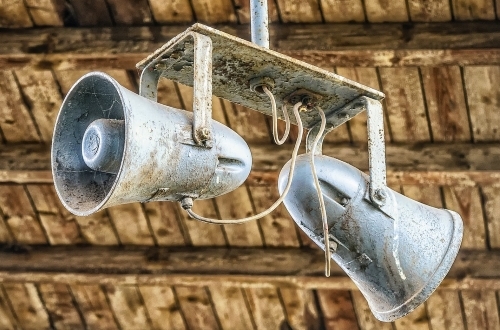When was the last time that you listened analytically to the loudspeakers in your sanctuary and perhaps other spaces? I mean really, truly listened to them?
The reason that I ask is that, easily 80 percent of the church loudspeaker systems that I’m invited to evaluate and re-voice (“tune,” “EQ,” “optimize,” etc.) have something seriously wrong with them – something that the church sound techs and pastoral staff are totally unaware of.
Sometimes sound techs might be suspicious that things don’t quite sound right, but they just can’t pin their finger on what it is, let alone which loudspeaker has the problem. Often they say that they haven’t had time to sort it out. And the reality is that most don’t own the test gear to help them dig deeper into the problem.
Think there might be a problem here? (Figure 1) The relatively “flat” black trace is the frequency response at a main seating section. The purple trace is the frequency response of the same model of loudspeaker aiming at the adjacent seating area. Those seated in the house left section receive a good quality sound, yet those seated just across the aisle hear no high frequencies at all. Although this might be just a loose wire, more than likely the high-frequency driver in the loudspeaker aimed at the house right seating section is blown. The worship pastor and tech team just knew that the sound coverage wasn’t even, but didn’t know why. You can imagine the raised eyebrows when I revealed this fact to them!
Figure 1: Comparison of two loudspeakers covering adjacent seating areas
The Right Connections
On the same trip, I visited another church in a town 150 miles away where I discovered that one of the stage monitors was wired out of polarity. I walked on stage with the four monitors lit up and knew within three seconds that one of them was out of polarity. It’s an unmistakable sound character that can anyone can identify quickly once they’re taught.
Now, I knew that one of the monitors was wired incorrectly, but I didn’t know which one, let alone where the incorrect connection was. It could be anywhere. So I took a moment to prove it out with a TEF analyzer. I’ve turned off the frequency response trace in this graph (Figure 2) to focus on the phase (it wasn’t pretty). The green and magenta traces show the phase response of those two floor monitors.
Figure 2: Two loudspeakers wired out of polarity
Note that one of the two traces shows a polarity reversal as compared with the other. A little investigation and frankly some head scratching ultimately pointed to the fact that the wiring inside the floor box was inverted on one of the four Neutrik SpeakON connectors. The astute reader quickly grasps the fact that this system had been wired this way for years and yet no one had recognized there was a problem. The vocalists on stage had simply accepted the fact that this was normal.
Miswiring a connector is easy enough to do if one is in a hurry and doesn’t have a magnifying glass to read the ridiculously small numbers stamped into the connector. But that’s no excuse for not confirming proper polarity with the wiring. The installer has a 50/50 chance of getting it right the first time! On top of that, often the company that installed the system didn’t pull individual cables to each loudspeaker. As a cost/ labor saving measure, many will parallel the loudspeakers if they’re flown. Sure, this saves money, but the shortcut makes it impossible to listen individually to each loudspeaker.
Pay Attention To Polarity
A couple of years ago a well-known sound contracting company was installing systems I’d designed at two separate projects. Everything they installed in the main sanctuary worked perfectly. But when I went to test the subwoofers in the gymnasium, there was virtually no output.
The two subs were placed next to each other in a solid “bunker” built into the front edge of the platform, right on the center line. So I asked them to pull the subs out of the bunker and check the wiring, and sure enough – one of the two subwoofers was wired out of polarity (i.e., the wires to the “positive” and “negative” connection were reversed). Once the wiring was corrected, the subs delivered the expected output.
As a sidebar: Remember that when a microphone picks up a sound wave, the mic turns the acoustic energy into an electrical signal. Every piece of mic information that I’ve ever read states something to the effect that “a positive acoustic pressure applied to the microphone diaphragm will produce a positive voltage on pin 2 with respect to pin 3.”
The sound system should be wired such that when that condition exists, the loudspeaker drivers push “out” towards the listener. Of course, that electrical signal is an alternating current (AC), and the loudspeaker drivers are going to push out and then back in response to that alternating acoustic pressure. But ideally, we would like the sound system energy to agree with the acoustic energy it’s receiving.
If the entire system were wired in reverse polarity, it could be argued that few listeners would hear the difference. The real problem comes when one loudspeaker is wired out of polarity with respect to the rest of the system, and its sound waves interact with sound from other loudspeakers in that system. Keep reading and I’ll share another story that clearly illustrates what can happen from such a simple wiring mistake.
It Happened Again…
Fast-forward to a second church clear across the country, where a different installation crew from the same sound contractor company was installing another system I’d designed. What are the odds that this other crew would repeat the very same mistake that their counterparts had done one week before? You guessed it – one of the guys had wired one of the two subwoofers out of polarity, and I had to have them pull them out of the bunker and correct the wiring mistake.
The bottom line is that, despite what we might think otherwise, this stuff happens. Far too often. Often enough that I’ve found that I can’t just trust the crew doing the install. I work with some great installers, and they’re driven to make it right the first time. But even the best of us can get in a hurry or get lost in the forest of cabling and accidentally invert the wiring. It happens. But without someone taking the time to check on things before the project is considered “complete,” you don’t know for certain that everything was in fact done correctly. Worse, if you weren’t around when the system was installed and you’ve “inherited” it, you may have also inherited some surprise mistakes.
Constant Attention
Oh, the stories I could tell, but I’ll save those for another time. For now, what’s a church tech to do? For starters, never stop listening analytically. If at all possible, at least once a year make it a routine preventative maintenance step to go through the loudspeaker system and carefully listen to each one individually. Further, if possible, turn off all but one of the power amplifiers so you can isolate and listen to (hopefully) just one loudspeaker at a time. At least minimize what you’re hearing so that the sound from the other loudspeakers isn’t masking the problem.
Loudspeaker drivers tend to fatigue over time. That is especially true for systems driven really hard. And if they’re driven too hard, things can break. You may be absolutely convinced that your system has never, ever been driven loud at all. Could it be that maybe, just maybe, someone is in your sanctuary tonight cranking up the loudspeaker system at 3 am when you’re sound asleep? Stranger things have happened.
Your congregation deserves to hear the Word preached clearly, as loud as needed, and without concern for feedback or muffled sound. Don’t be afraid to call in professional help. Bring in someone who has the knowledge, the skills, the experience and the test equipment to ensure that loudspeaker systems do their part with excellence.






















